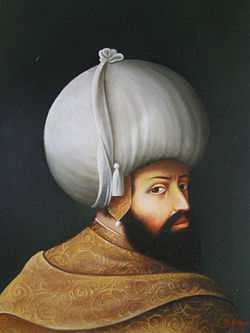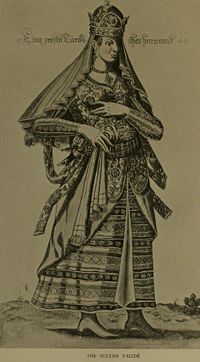Sultan
2008/9 Schools Wikipedia Selection. Related subjects: Politics and government
Sultan (Arabic: سلطان) is an Islamic title, with several historical meanings. Originally it was an Arabic language abstract noun meaning "strength", "authority", or "rulership", derived from the Arabic masdar سلطة sulṭah, meaning "authority" or "power". Later, it came to be used as the title of certain Muslim rulers who claimed almost full sovereignty in practical terms (i.e., the lack of dependence on any higher ruler), without claiming the overall Caliphate, or it was used to refer to a powerful governor of a province within the caliphate. It then developed some further meanings in certain contexts.
The dynasty and lands ruled by a Sultan are called a Sultanate (Arabic: سلطنة).
Muslim ruler under the terms of shariah

The title carries moral weight and religious authority, as the ruler's role was defined in the Qur'an. The Sultan however is not a religious teacher himself. Of course in constitutional monarchies, the sultanship can be reduced to a more limited role.
The first to carry the title of 'Sultan' was the Turkmen chief Mahmud of Ghazni (ruled 998 - 1030). Later, 'Sultan' became the usual title of rulers of Seljuk and Ottoman Turks and Ayyubid and Mamluk rulers in Egypt. In the later stages Sultan was used mostly for the wives of the emperor. The religious validation of the title was illustrated by the fact that the shadow Caliph in Cairo bestowed the title "Sultan" on Murad I, the third ruler of the emerging Ottoman Empire in 1383; its earlier sovereigns had been (protocollary 'mere') Beys or Emirs.
At later stages, lesser rulers assumed the style "sultan", as was the case for the earlier leaders of today's royal family of Morocco. Today, only the Sultan of Oman, the Sultan of Brunei (both sovereign nations), the Sultans of Johor, Kedah, Kelantan, Pahang, Perak, Selangor and Terengganu (within the constitutive states of the federation) in Malaysia, and some titular sultans found in the southern Philippines and Java (Indonesia) regions still use the title. The sultan's domain is properly called a sultanate. A feminine form, used by Westerners, is sultana or sultanah; the very styling misconstrues the roles of wives of sultans. In a similar usage, the wife of a German Field-Marshal might be styled Feldmarschallin (in French, similar constructions of the type madame la maréchalle are quite common).
Among those modern hereditary rulers who wish to emphasize their secular authority under the rule of law, the term is gradually being replaced by 'king' (e.g. Malik in Arabic).
Compound ruler titles
These are generally secondary titles, either lofty 'poetry' or with a message; e.g.:
- Mani Sultan = Manney Sultan, meaning 'the Pearl or rulers', or less poetically Honoured Monarch, was a subsidiary title, part of the full style of the Maharaja of Travancore
- Sultan of Sultans is the 'sultanic equivalent' of King of Kings
- Certain secondary titles have a devout Islamic connotation, e.g. Sultan ul-Mujahidin as champion of jihad bis saif (holy war to establish Islamic rule)
- Sultanic Highness was a rare, hybrid western-Islamic honorific style, exclusively used by the son, daughter-in-law and daughters of Sultan Husain Kamil of Egypt (a British protectorate since 1914), who bore it with their primary titles of Prince (Arabic Amir, Turkish Prens) or Princess, after 11 October 1917. They enjoyed these for life, even after the Royal Rescript regulating the styles and titles of the Royal House after the Egyptian Independence in 1922, when the sons and daughters of the newly styled King (Arabic Misr al- Malik, considered a promotion) were granted the style Sahib(at) us-Sumuw al-Malik, or Royal Highness).
Contemporary sultanates
- Brunei
- Indonesia — Sultan of Yogyakarta Special Region is governor of that province
- Malaysia
- Note: Sultan is the title of seven ( Johor, Kedah, Kelantan, Pahang, Perak, Selangor and Terengganu) of the nine rulers of the Malay states. The federal head of state for all Malaysia, the Yang di-Pertuan Agong, is elected (de facto rotated) for five years by and among the hereditary state rulers, but is usually styled "king" in foreign countries; political power, however, lies with the prime minister. See also: Malay titles
- Oman, an Arabian nation, formerly sultanate of Muscat and Oman
Princely and aristocratic titles
In the Ottoman dynastic system, male descendants of the ruling Padishah (in the West also known as Great Sultan), enjoyed a style including Sultan, so this normally Monarchic title is used equivalent to a western prince of the blood: Daulatlu Najabatlu Shahzada Sultan (given name) Hazretleri Effendi; for the Heir Apparent however, the style was Daulatlu Najabatlu Vali Ahad-i-Sultanat' (given name) Effendi Hazlatlari, i.e. Crown Prince of the sultanate.
- The sons of Imperial Princesses, excluded from the Ottoman imperial succession, were only styled Sultanzada (given name) Bey-Effendi, i.e. Son of a Prince[ss] of the dynasty.
In certain Muslim states, Sultan was also an aristocratic title, as in the Tartar Astrakhan Khanate
The Sultan Valide was the title reserved for the mother of the ruling sultan.
Military rank
In a number of post-caliphal states under Mongol or Turkic rule, there was a feudal type of military hierarchy, often decimal (mainly in larger empires), using originally princely titles ( Khan, Malik, Amir) as mere rank denominations.
In the Persian empire, the rank of Sultan was roughly equivalent to a western Captain, socially in the fifth rank class, styled 'Ali Jah

